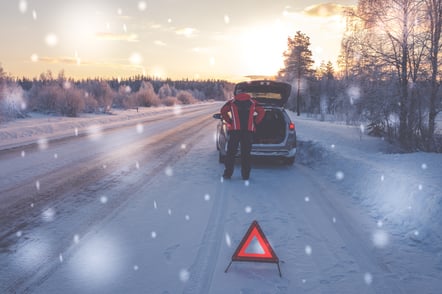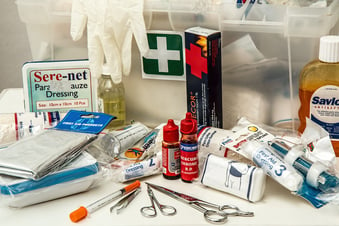Being prepared for a breakdown could save your life, especially during the winter months. Whether your vehicle breaks down or you slide off the road and have to wait

quite a while for a tow truck, you'll be glad to have a proper emergency travel kit for your car. To save space in your vehicle, tailor your emergency kit to the season. In the summer, you won't need heavy blankets, but you'll be glad for them during the winter. Of course, some items come in handy no matter the weather.
Sustenance. The longer your body goes without water and food, the weaker you become. While a few hours is fine, if you are in a remote location on the way to a ski trip or a winter vacation at a cabin in the mountains, it's possible that help may take longer to get to you, especially in blizzard conditions.
 Water. Carry at least 2 liters of water for each person in the vehicle. If you have space where it won't freeze, carry more.
Water. Carry at least 2 liters of water for each person in the vehicle. If you have space where it won't freeze, carry more.
Non-perishable, high-energy foods. Pack protein bars, peanut butter and crackers and, during the winter, chocolate. Avoid options with too much salt as they will make you more thirsty. Beef jerky is another good food to pack in your emergency kit. Don't forget to rotate the food every couple of months or by the 'use by' date.
Water Purification Tablets. If you do have to melt snow to drink or drink water from a creek, you'll have a way to purify it.
Survival. Hypothermia is one of the most dangerous situations you can get yourself into. Never rely on the gas in your tank to last until someone can rescue you, especially in remote areas. Pack a wool blanket for each person in the vehicle. Everyone should also have a change of warm clothing and an extra jacket. If your clothing gets damp, you'll be more apt to suffer from hypothermia. Chemical heat packs will also help keep you warm if you put them under a blanket. Many last for up to 15 hours.
Additional survival gear that you should have includes:
- Flashlight & extra batteries
- Matches, preferably waterproof or in a waterproof container
- Candles
- Waterproof poncho with a hood
- Whistle
- Reflective triangles
- Hand-crank-powered light with radio and cell phone charger
- Tarp
- Knife
- Hatchet
A first aid kit is always a good idea and should have more than just the basics:
 Gauze bandages and medical tape
Gauze bandages and medical tape- Eyewash
- Nitrile gloves
- Small towels to clean wounds
- Absorbent pads to press onto wounds
- Antiseptic wipes and burn cream
- Aspirin and/or non-aspirin pain relievers
- Needle and thread
- Superglue (for minor cuts that may need one or two stitches)
- Tweezers, scissors, and a knife that can be sterilized
Recovery and Other Supplies. Additional items you should have to help yourself if possible include tire chains, a shovel, a tow strap, jack and tools to change a tire along with small hand tools like screw drivers, and an adjustable wrench.






